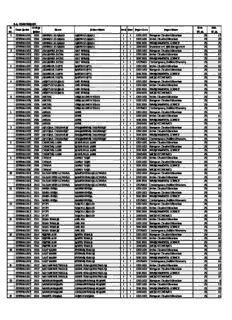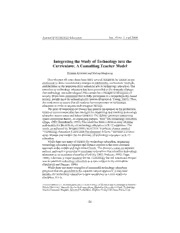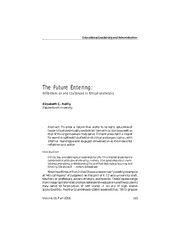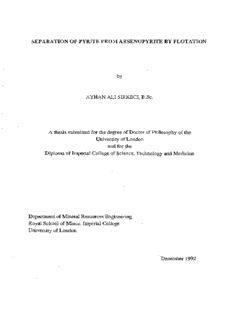
SEPARATION OF PYRITE FROM ARSENOPYRITE BY FLOTATION by AYHAN ALI SIRKECI, B.Sc ... PDF
Preview SEPARATION OF PYRITE FROM ARSENOPYRITE BY FLOTATION by AYHAN ALI SIRKECI, B.Sc ...
SEPARATION OF PYRITE FROM ARSENOPYRITE BY FLOTATION by AYHAN ALI SIRKECI, B.Sc. A thesis submitted for the degree of Doctor of Philosophy of the University of London and for the Diploma of Imperial College of Science, Technology and Medicine Department of Mineral Resources Engineering Royal School of Mines, Imperial College University of London December 1992 Abstract This thesis reports investigations into the flotation separation of pyrite from arsenopyrite using xanthates and the new collectors Fl, S7 and F2B developed by Dow Chemical Company. The Dow surfactants were classified as chelating collectors by the manufacturer. For this purpose Hallimond tube, bench and column flotation tests were run in order to assess the flotation behaviour of these minerals. In addition to these experiments other tests performed were adsorption characteristics of Fl on pyrite and arsenopyrite, the effect of Fl on electrophoretic mobility and surface tension of Fl solutions. The effect of pH on the recovery of pyrite and arsenopyrite was studied for all collectors with the Hallimond tube. pH values ranging from 2 to 12 were tested at constant collector concentrations. At the optimum pH values further experiments were carried out under varying collector concentrations. The results obtained for five different collectors showed that selectivity was rather poor at all conditions except for Fl. A successful separation was seen to be possible employing Fl and by floating pyrite. This was proven by using a mixture of equal amounts of pyrite and arsenopyrite and selectively floating pyrite. Bench and column flotation tests were carried out in order to confirm the results obtained with the Hallimond tube. A Denver flotation cell was used and a column cell was constructed. In these tests Fl was used as a collector and in some cases amyl xanthate was blended. The effect of collector concentration was monitored and other parameters were adjusted for an optimum separation. Observations showed that a selective flotation of pyrite from arsenopyrite could be possible. Adsorption characteristics of Fl on pyrite and arsenopyrite were studied as a function of collector concentration, pH and time. Though there was not a direct correlation between the amount of Fl adsorbed and the success of flotation, in general pyrite was found to adsorb more Fl than arsenopyrite. Electrophoretic mobility of pyrite and arsenopyrite against pH and collector concentration was measured. It was observed that Fl did not have a substantial effect on the electrophoretic mobility of these minerals. The measured pK value of Fl indicated that most of the collector in solution was in molecular form above pH 9.2. Acknowledgements I would like to take this opportunity to thank; My supervisors Dr. R.J. Gochin and Dr. A.J. Monhemius for their advice and guidance, Prof. A.R. Burkin for his kind suggestions. My thanks are also due to: Past and present members of the hydrometallurgy group; Elia, Themis, Heidi, Veronica, Luis, Peter, Mike Haddon, Roberto and Steve for their sincere friendship, encourage, understanding and support throughout the years I shared with them otherwise, I believe, would be unbearable. And also Timur Ustaomer for his true and invaluable friendship. Mr. J. Burgess, Mr. V. Harris and Mr. Colin Richardson for their technical assistance and help. The National Educational Ministry of Turkey for their financial support. The Dow Chemical Company (Germany), and Mr. Simon Isherwood for supplying the collectors Fl, S7 and F2B. The Cyanamid Company (The Netherlands) for supplying the xanthates. The Spectratech Company and especially Mr. Alan Strawn for conducting FTIR analyses. And last but certainly not the least my sister who always supported, encouraged and loved me all my life with a care and affection of a mother; my gratitude can not likely be expressed in any language in the world. I can not possibly finish my words without stating my deep respect, love and agony that I feel about my mother, who passed away almost a year ago. She sacrificed herself for her beloved children just to see them happy, you will always live in my heart. Rest in peace. 4 Dedication To my mother, father and sister. Table of Contents Abstract 2 Acknowledgements 3 Dedication 4 Table of Contents 5 Table of Figures 8 Contents of Tables 12 CHAPTER 1 13 INTRODUCTION 13 Introduction 14 CHAPTER II 21 LITERATURE SURVEY 21 2.1. Review of Surface Characteristics of Sulphides 22 2.1.1. Introduction 22 2.1.2. Xanthate-Sulphide Mineral Interactions 28 2.1.3. Oxidation Reactions on the Surface of Pyrite 32 2.1.4. Oxidation Reactions on Arsenopyrite Surfaces 36 2.1.5. Effect of Semiconductivity on Surface Reactions 38 2.2. Review of Flotation Studies Carried Out on Pyrite and Arsenopyrite 40 2.3. Collectors 46 2.3.1. Introduction 46 2.3.2. Behaviour of Xanthates in Different Solutions 48 2.3.3. Complexes and Chelating Collectors 49 2.3.4. New Collectors Used in This Study 52 2.4. Column Flotation 54 CHAPTER III 59 METHODS AND MATERIALS 59 3.1. Description of Research Techniques 60 3.1.1. Hallimond Tube Tests 60 3.1.2. Bench Flotation 61 3.1.3. Column Flotation 62 3.1.4. Adsorption Tests 64 3.1.5. Electrophoretic Mobility Measurements 64 3.2. Description of Materials Used and Preparation 65 3.3. Description of Analytical Techniques 67 3.4. FTIR Studies 68 3.5. Surface Tension Measurements 69 CHAPTER IV 75 PYRITE FLOTATION 75 4.1. Hallimond Tube Flotation Tests 76 4.1.1. Flotation with Xanthates 76 4.1.2. Flotation with S7 78 4.1.3. Flotation with F2B 80 4.1.4. Flotation with F1 81 4.2. Adsorption 84 4.2.1. The Effect of Time on Adsorption 84 4.2.2. Adsorption Isotherms 86 4.2.3. The Effect of pH on Adsorption 88 4.3. Desorption 89 4.4. Electrophoretic Mobility 90 4.4.1. Electrophoretic Mobility Against pH 91 4.4.2. Electrophoretic Mobility with Respect to pH at Constant F1 Concentration 92 4.4.3. The Effect of Increasing F1 Concentration on Electrophoretic Mobility at Constant pH 92 4.4.4. The Effect of Dodecylamine and F1 on the Electrophoretic Mobility of Quartz at Constant pH 94 4.4.5. The Effect of Dodecylamine Concentration on the Electrophoretic Mobility of Pyrite at Constant pH 96 CHAPTER V 97 ARSENOPYRITE FLOTATION 97 5.1. Hallimond Tube Flotation Tests 98 5.1.1. Flotation with Xanthates 98 5.1.2. Flotation with S7 and F2B 98 5.1.3. Flotation with F1 100 5.2. Adsorption 102 5.2.1. Time Dependency of F1 Adsorption 102 5.2.2. Adsorption Against F1 Concentration 102 5.2.3. The Effect of pH on the Adsorption 105 5.3. Desorption 105 5.4. Electrophoretic Mobility 106 5.4.1. Electrophoretic Mobility Against pH 107 5.4.2. The Effect of F1 Concentration on the Electrophoretic Mobility 107 CHAPTER VI 109 SEPARATION TESTS 109 6.1. Introduction 110 6.2. Hallimond Tube Flotation 110 6.3. Bench Flotation 114 6.4. Column Flotation 120 6.4.1. Introduction 120 6.4.2. Experimental Results 121 CHAPTER VII 130 DISCUSSION, CONCLUSIONS AND FUTURE WORK 130 7.1. Discussion 131 7.1.1. Introduction 131 7.1.2. Pyrite 132 7.1.3. Arsenopyrite 144 7.1.4. Separation Tests 149 7.1.4.1. Hallimond Tube Flotation 149 7.1.4.2. Bench Flotation 150 7.1.4.3. Column Flotation 151 7.3. Conclusions 154 7.4. Future Work 156 Appendix 1 157 Appendix 11 160 REFERENCES 163 Table of Figures Figure 1.1. The minerals formed in the Fe-As-S system 16 Figure 2.1. Distribution of charges across a solid surface and solution according to Helmotz's model of double layer 24 Figure 2.2. The decay of surface potential with respect to distance from the surface after Gouy and Chapman 25 Figure 2.3. The distribution of potential into the interior of solution according to Stem's model 26 Figure 2.4. Potential distribution across the double layer after the modification of the Stem layer 26 Figure 3.1. The schematic diagram of the Hallimond tube used in this investigation 61 Figure 3.2. The schematic diagram of the column cell used in this study 63 Figure 3.3. The spectra of Fl, and pyrite powders conditioned in F1 solutions of different pH. (a) Fl, (b) pH 5, (c) pH 10, (d) pH 11 70 Figure 3.4. The surface tension of Fl at around pH 5.0-5.5 72 Figure 3.5. Surface tension of Fl and dodecylamine at pH 11 and 10.4 respectively 73 Figure 3.6. Surface tension of Fl and dodecylamine against pH 73 Figure 4.1. Flotation of pyrite with 6.94*10'^ mol/1 ethyl and 4.95*10"^ mol/1 amyl xanthates 77 Figure 4.2. Flotation of pyrite with ethyl and amyl xanthates at pH 4 and 3.5 respectively 77 Figure 4.3. Flotation of pyrite with S7 at 8.4*10"6 mol/1 collector concentration 79 Figure 4.4. Flotation of pyrite recovery against S7 concentration at pH 3 79 Figure 4.5. Recovery of pyrite with 2 mg/1 F2B concentration 80 Figure 4.6. Recovery of pyrite and quartz using Fl at different pH 82 Figure 4.7. The effect of increasing Fl concentration on the recovery 82 Figure 4.8. The effect of conditioning on the flotation of pyrite at increasing Fl concentrations 83 Figure 4.9. Adsorption of Fl onto pyrite against time around pH 11. Initial collector concentration is 5.06*10"^ mol/1 85 Figure 4.10. Adsorption of Fl onto pyrite against time around pH 11. Initial collector concentration is 2.53*10"^ mol/1 85 Figure 4.11. Adsorption of F1 onto pyrite against time around pH 4.6. Initial collector concentration 2.53*10"^ mol/1 86 Figure 4.12. Adsorption density on pyrite against final F1 concentration at two different pH values 87 Figure 4.13. Variation of sulphate concentration in solution with F1 87 Figure 4.14. The effect of pH on the adsorption density of F1 on pyrite 88 Figure 4.15. Desorption ability of F1 off the pyrite surface 89 Figure 4.16. The effect of pH on the electrophoretic mobility of pyrite in the presence and absence of F1 92 Figure 4.17. The effect of increasing F1 concentration on the electrophoretic mobility of pyrite at two different pH values 93 Figure 4.18. The effect of swapping pH across the iep on the EM of pyrite in the presence and absence of F1 94 Figure 4.19. The effect of dodecylamine concentration on the electrophoretic mobility of quartz in acidic and alkaline solutions 95 Figure 4.20. The effect of F1 concentration on the electrophoretic mobility of quartz in acidic and alkaline solutions 95 Figure 4.21. The effect of dodecylamine on the electrophoretic mobility of pyrite at pH 10 96 Figure 5.1. The flotation of arsenopyrite with 6.94*10"^ mol/1 NaEX and 4.95*10-5 mol/1 KAX 99 Figure 5.2. The effect of increasing NaEX and KAX concentration on the flotation recovery of arsenopyrite at pH 3.2 and 3.5 respectively 99 Figure 5.3. Flotation recovery of arsenopyrite with 8.4*10"'^ mol/1 S7 and 2 mg/1 F2B 100 Figure 5.4. Flotation of arsenopyrite using 1.01*10-5 mol/1 F1 101 Figure 5.5. The effect of preconditioning and using Ca(0H)2 as pH regulator on the recovery of arsenopyrite around pH 10 101 Figure 5.6. Time dependency of F1 adsorption onto arsenopyrite at pH 10 103 Figure 5.7, Time dependency of F1 adsorption onto arsenopyrite at pH 11 103 Figure 5.8. Adsorption density of F1 on arsenopyrite against final concentration 104 Figure 5.9. The arsenic concentration in the solutions with respect to the initial F1 concentration 104 10 Figure 5.10. The effect of pH on the adsorption density of F1 105 Figure 5.11. F1 desorption off the surface of arsenopyrite on diluting the solution after adsorption 106 Figure 5.12. The electrophoretic mobility of arsenopyrite against pH 107 Figure 5.13. The effect of increasing F1 concentration on the E.M. of arsenopyrite in acidic and alkaline solutions 108 Figure 6.1. The arsenopyrite content of the flotation products Ill Figure 6.2. The arsenopyrite recovery of the flotation products Ill Figure 6.3. The pyrite content of the flotation products 113 Figure 6.4. The pyrite recovery of the flotation products 113 Figure 6.5. The effect of collector concentration on the sulphide selectivity 115 Figure 6.6. The effect of using distilled water and grinding pyrite and arsenopyrite together on selectivity 115 Figure 6.7. The effect of applying a cleaning flotation on the selectivity for two different samples 116 Figure 6.8. The recovery of pyrite and arsenopyrite against F1 concentration for the concentrate 117 Figure 6.9. The pyrite and arsenopyrite grades in the concentrate against F1 concentration 118 Figure 6.10. The effect of different treatments on the recovery 118 Figure 6.11. The effect of treatments on the grade of pyrite and arsenopyrite in the concentrate 119 Figure 6.12. The change in the recovery and grade of pyrite with the gas and feed rate 121 Figure 6.13. The flotation response of quartz with 5.06*10'^ mol/1 F1 122 Figure 6.14. A typical progress of flotation in the column cell 123 Figure 6.15. The effect of using wash water on the recovery and grade of pyrite and arsenopyrite 124 Figure 6.16. The effect of negative and positive bias on the grade and recovery of pyrite and arsenopyrite 125 Figure 6.17. The effect of using arsenopyrite with a high copper content on the flotation 125 Figure 6.18. The change in the recovery and grade with respect to F1 concentration 126 Figure 6.19. The effect of pH on the recovery of pyrite and arsenopyrite 127 Figure 6.20. The recovery ratio of pyrite and arsenopyrite under the conditions as in Figure 6.19 127
Description:The list of books you might like

Can’t Hurt Me: Master Your Mind and Defy the Odds

Believe Me

Credence

Mind Management, Not Time Management

La guerra de dos mundos

Hindi Kahanikaro Ke Kathachintan Ke Sandrabh Main Unke Kahani Sahitya Ka Mulyakan

Évaluations formative et certificative des apprentissages
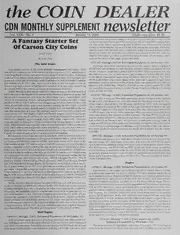
The Coin Dealer Newsletter Monthly Supplement Newsletter: 2006
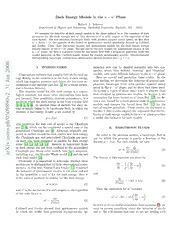
Dark Energy Models in the w - w' Plane
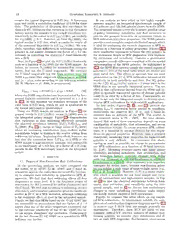
Optical Star-Formation Rate Indicators

Это было навсегда. 1968-1985.
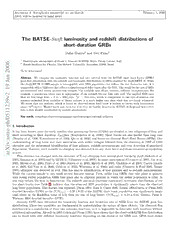
The BATSE-Swift luminosity and redshift distributions of short-duration GRBs
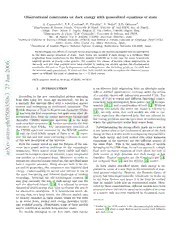
Observational constraints on dark energy with generalized equations of state
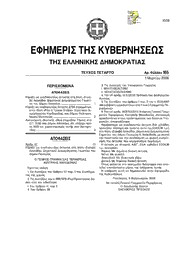
Greek Government Gazette: Part 4, 2006 no. 165
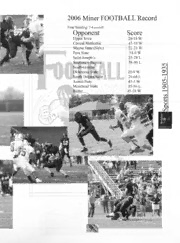
The Rollamo 2006
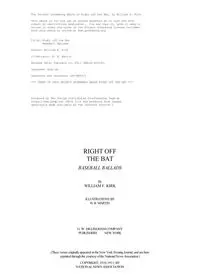
Right off the Bat by William F Kirk
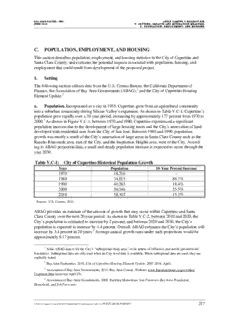
C. POPULATION, EMPLOYMENT, AND HOUSING - Amazon S3

C opyleft—the economics of Linux and other open source - Angelfire
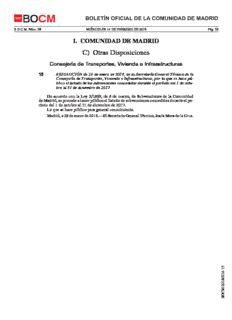
C) Otras Disposiciones
